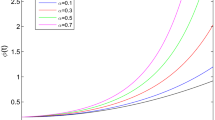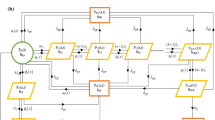Abstract
This study investigates condition-based switching and replacement policies for a two-unit warm standby redundant system subject to non-instantaneous switchover. The system consists of two identical units: one is operating unit, while the other is standby unit. Two units are under continuous monitoring and degradation described by Gamma processes. Both switching and replacement policies are based on the degradation level of the operating unit. The switching and replacement thresholds are decision variables decided by minimizing the long-run expected cost rate. We first setup the mathematical optimization model and then analyze the global optimal solution of replacement threshold, as well as the existence and uniqueness condition for the local optimal solution of switching threshold (STH). Finally, we find that the optimal replacement threshold is “the bigger the better”, but the optimal STH depends on some optimal conditions which can be easily computed. Numerical examples are provided to verify the policies, and the effects of non-instantaneous switchover and cost ratio on optimal STHs are numerically discussed.






Similar content being viewed by others
References
Amari SV, Dill G (2010) Redundancy optimization problem with warm-standby redundancy. In: IEEE (ed) Reliability and maintainability symposium (RAMS), 2010 proceedings. Annual reliability and maintainability symposium/international symposium on product quality and integrity, San Jose, January 2010. IEEE, New York, pp 1–6
Yun WY, Cha JH (2010) Optimal design of a general warm standby system. Reliab Eng Syst Saf 95:880–886
EL-Sherbeny MS (2010) The optimal system for series systems with mixed standby components. J Qual Maint 16:319–334
Zhang T, Xie M, Horigome M (2006) Availability and reliability of k-out-of-(M+N): G warm standby systems. Reliab Eng Syst Saf 91:381–387
Wang H (2002) A survey of maintenance policies of deteriorating systems. Eur J Oper Res 139:469–489
Jardine AKS, Lin D, Banjevic D (2006) A review on machinery diagnostics and prognostics implementing condition-based maintenance. Mech Syst Signal Process 20:1483–1510
Ahmad R, Kamaruddin S (2012) An overview of time-based and condition-based maintenance in industrial application. Comput Ind Eng 63:135–149
Nakagawa T, Osaki S (1976) A summary of optimum preventive maintenance policies for a two-unit standby redundant system. Math Method Oper Res 20:171–187
Lee HS, Srinivasan MM (1994) Optimal replacement policies for systems with multiple standby components. IEEE T Reliab 43:414–422
Dohi T, Osaki S, Kaio N (1996) Optimal planned maintenance with salvage cost for a two-unit standby redundant system. Microelectron Reliab 36:1581–1588
Yu H, Yalaoui F, Châtelet Ė et al (2007) Optimal design of a maintainable cold-standby system. Reliab Eng Syst Saf 92:85–91
Lam Y (1997) A maintenance model for two-unit redundant system. Microelectron Reliab 37:497–504
Zhang YL, Wang GJ, Ji ZC (2006) Replacement problems for a cold standby repairable system. Int J Syst Sci 37:17–25
Zhang YL, Wang GJ (2007) A deteriorating cold standby repairable system with priority in use. Eur J Oper Res 183:278–295
Leung KNF, Zhang YL, Lai KK (2010) A bivariate optimal replacement policy for a cold standby repairable system with repair priority. Nav Res Logist 57:149–158
Leung KNF, Zhang YL, Lai KK (2011) Analysis for a two-dissimilar-component cold standby repairable system with repair priority. Reliab Eng Syst Saf 96:1542–1551
Yuan L, Xu J (2011) An optimal replacement policy for a repairable system based on its repairman having vacations. Reliab Eng Syst Saf 96:868–875
Jia J, Wu S (2009) Optimizing replacement policy for a cold-standby system with waiting repair times. Appl Math Comput 214:133–141
Hsieh CC, Chiu KC (2002) Optimal maintenance policy in a multistate deteriorating standby system. Eur J Oper Res 141:689–698
Hsieh CC (2005) Replacement and standby redundancy policies in a deteriorating system with aging and random shocks. Comput Oper Res 32:2297–2308
Abdel Maksoud EY, Moustafa MS (2009) A semi-Markov decision algorithm for the optimal maintenance of a multistage deteriorating two-unit standby system. Oper Res Int J 9:167–182
Van Noortwijk JM (2009) A survey of the application of gamma processes in maintenance. Reliab Eng Syst Saf 94:2–21
Tan L, Yang J, Cheng Z et al (2011) Optimal replacement policy for cold standby system. Chin J Mech Eng-En 24:1–7
Gurov SV, Utkin LV (1996) Cold standby systems with imperfect and noninstantaneous switch-over mechanism. Microelectron Reliab 36:1425–1438
Srinivasan VS (1968) A standby redundant model with noninstantaneous switchover. IEEE T Reliab 17:175–178
Kurz R, Brun K (2001) Degradation in gas turbine systems. J Eng Gas Turbines Power 123:70–77
Van Noortwijk JM (2003) Explicit formulas for the variance of discounted life-cycle cost. Reliab Eng Syst Saf 80:185–195
Bérenguer C, Grall A, Dieulle L et al (2003) Maintenance policy for a continuously monitored deteriorating system. Probab Eng Inf Sci 17:235–250
Acknowledgments
This work was partially supported by the National Natural Science Foundation of China (61210012, 61021063, 61290324) and the National Science and Technology Major Project (2011ZX02504-008).
Author information
Authors and Affiliations
Corresponding author
About this article
Cite this article
Jiang, Y., Chen, M. & Zhou, D. Condition-based switching and replacement policies for a two-unit warm standby redundant system subject to non-instantaneous switchover. Chin. Sci. Bull. 59, 4616–4624 (2014). https://doi.org/10.1007/s11434-014-0585-y
Received:
Accepted:
Published:
Issue Date:
DOI: https://doi.org/10.1007/s11434-014-0585-y




